Did you know that, between all the states in the U.S. of A., Texas has the most birds? According to records, there are over 655 species of birds in the Lone Star State, and a whopping 19 of them are hawks.
If you want to know more about hawks in Texas, you’re in the right place! We’ve compiled a list of each of these beautiful birds of prey, with information on what they look like, what they eat, and where you’re likely to find them. So without further ado, let’s dive in!
Red-Tailed Hawk

- Scientific Name: Buteo jamaicensis
- Length: 17.7-22.1 inches (males), 19.7-25.6 inches (females)
- Weight: 24.3-45.9 ounces (males), 31.8-51.5 ounces (females)
- Wingspan: 44.9-52.4 inches
Red-tailed hawks are among the most common hawks in Texas and the United States in general. In addition to their standard buteo appearance — complete with round, broad wings and a short, wide tail — they have a unique cinnamon-red tail, which is the trait that gives these birds of prey their names. They also have reddish-brown backs and pale streaked bellies.
This type of hawk is usually most active during the day and can easily be spotted soaring high in the sky. However, it’s uncommon to see one of these birds lurking around bird feeders, as they prefer feeding on larger birds over small songbirds.
Sharp-Shinned Hawk

- Scientific Name: Accipiter striatus
- Length: 9.4-13.4 inches
- Weight: 3.1-7.7 ounces
- Wingspan: 16.9-22.1 inches
The sharp-shinned hawks are fairly abundant in Texas and are characterized by their yellow-orange and white bars all over their breasts with dark blue-gray above. They’re also known for being not only the smallest bird of prey in Texas but the smallest in the entire continent of North America. Similar to many hawks on the list, this hawk is subject to sexual dimorphism, so the females’ and males’ sizes are noticeably different.
Despite their small stature, these birds of prey have an appetite and hunting habits that rival a larger hawk. They mostly feed on small or medium-sized birds, so don’t be surprised if you see these predators lurking around your backyard bird feeders.
Cooper’s Hawk
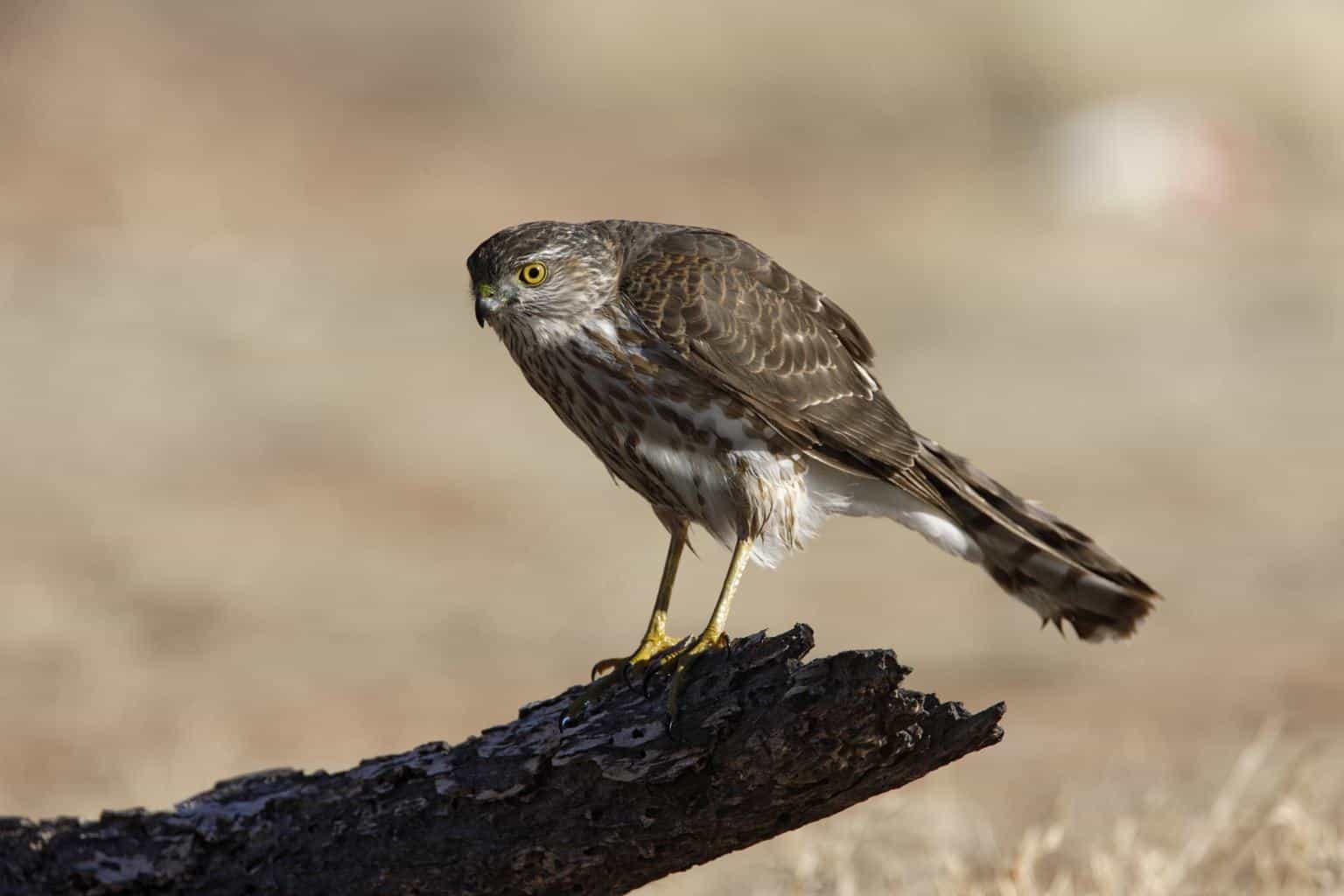
- Scientific Name: Accipiter cooperii
- Length: 14.6-15.3 inches (males), 16.5-17.7 inches (females)
- Weight: 7.8-14.5 ounces (males), 11.6-24.0 ounces (females)
- Wingspan: 24.4-35.4 inches (males), 29.5-35.4 inches (females)
Cooper’s hawk is an average-sized bird of prey that’s as large as a crow, and extremely similar to the sharp-shinned hawk in terms of looks. What makes them slightly different are the warm reddish bars that are found on the bird’s front along with the steely blue-gray back.
Cooper’s hawks are pretty easy to spot because they have a high affinity to lurk around bird feeders, as they feed almost exclusively on other birds.
Northern Goshawk

- Scientific Name: Accipiter gentilis
- Length: 20.9-25.2 inches
- Weight: 22.3-48.1 ounces
- Wingspan: 40.5-46.1 inches
Northern goshawks are among the largest accipiters in the United States. However, it’s hard to spot these birds of prey in Texas because of deforestation and the destruction of their preferred habitat, which is composed of heavily wooded forests.
You’ll be able to identify this hawk by its matte gray head, bright red eyes, and backward-swooping white line that runs through its face. They’re rather secretive birds who spend most of their days hunting for medium-sized birds and small mammals in coniferous forests.
Red-Shouldered Hawk
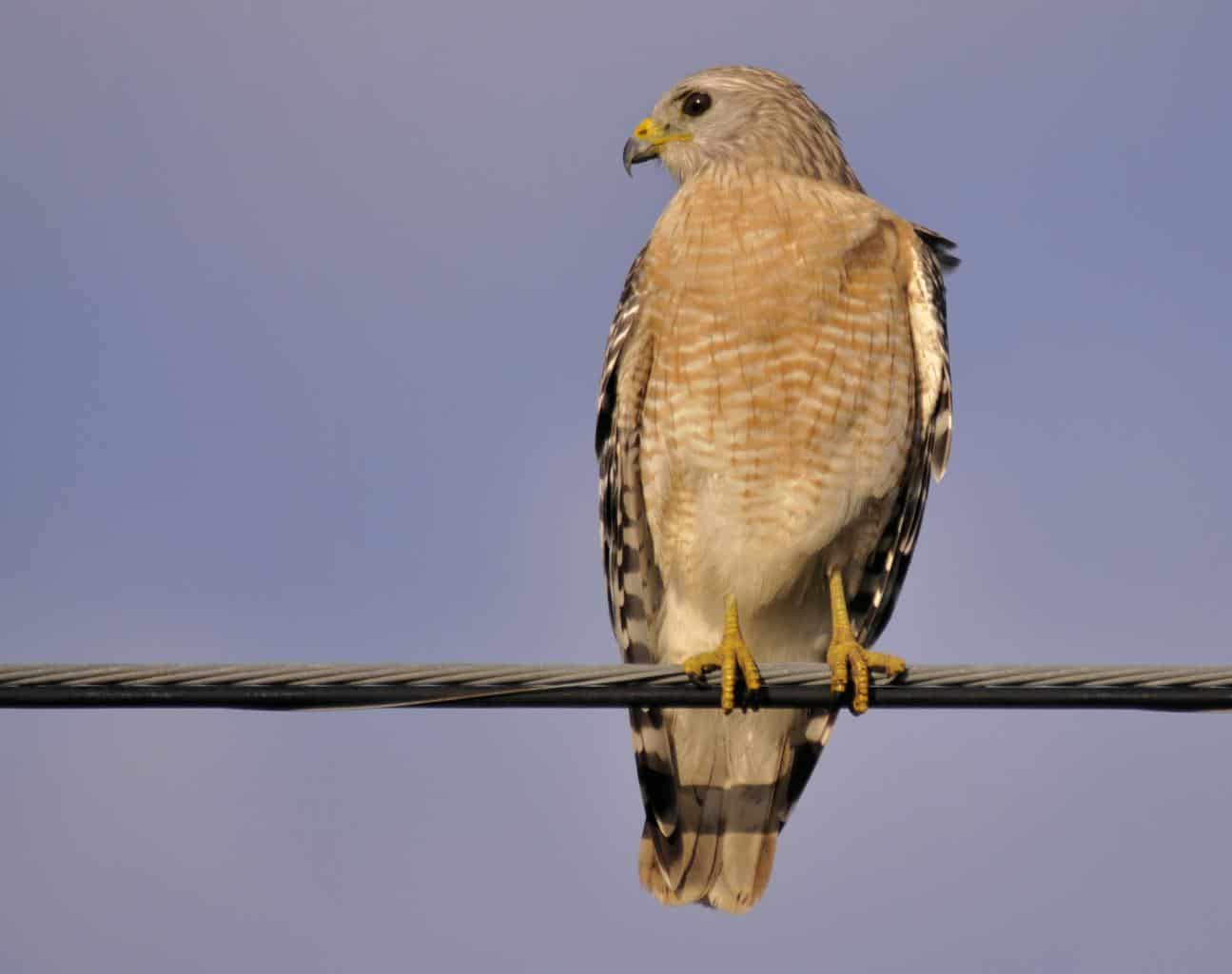
- Scientific Name: Buteo lineatus
- Length: 16.9-24.0 inches
- Weight: 17.1-27.3 ounces
- Wingspan: 37.0-43.7 inches
Red-shouldered hawks are huge fans of heavily wooded areas with multiple creeks and rivers nearby, as they mainly feed on amphibians, reptiles, and rodents. They’re most often seen perched in large trees or flying relatively low from one wooded spot to another.
They can be identified by their characteristic warm orange-red bars on the chest and shoulders as well as the checkered wings and streaked tails.
They’re most common in the east side of Texas, where you’ll likely find them hunting mammals like voles and chipmunks.
Broad-Winged Hawk
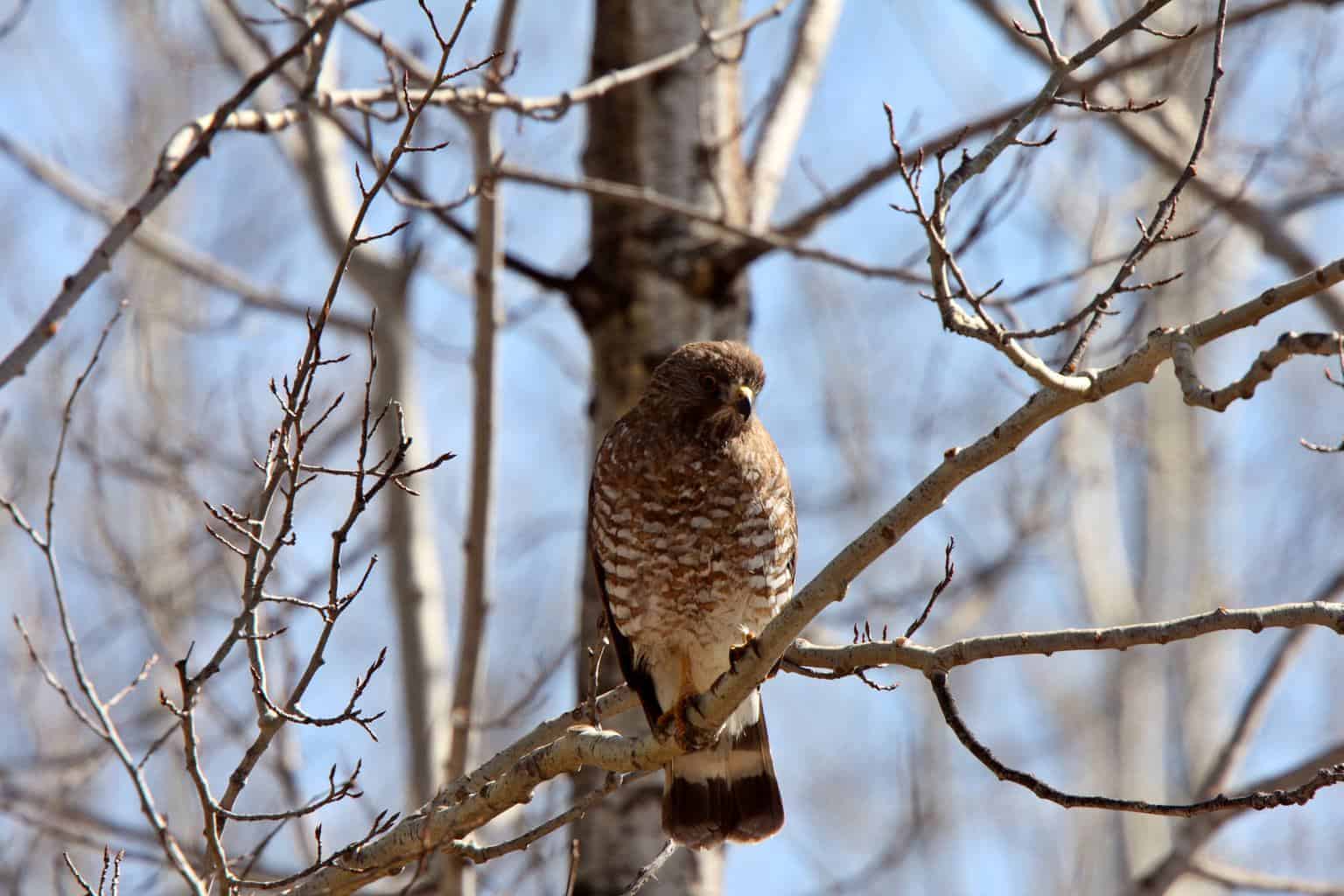
- Scientific Name: Buteo platypterus
- Length: 13.4-17.3 inches
- Weight: 9.3-19.8 ounces
- Wingspan: 31.9-39.4 inches
Broad-winged hawks are small to medium-sized hawks, but relative to the size of their bodies, their wings are quite large. These migrating birds live in Texas during the winter and head to the northern midwest region to breed.
As the bird’s name suggests, the broad wings are their most unique features, which also makes them pretty easy to spot. However, they also have a characteristic thick banded tail, a reddish-brown head, and barred underparts you can use to find these types of hawks.
Swainson’s Hawk

- Scientific Name: Buteo swainsoni
- Length: 18.9-22.1 inches
- Weight: 24.4-48.2 ounces
- Wingspan: 49 inches
The medium-sized Swainson’s hawk is known for its very long wingspan and reddish-brown chest that’s color fades as it goes down the abdomen.
The birds usually perch on cables and have one of the longest migration ranges of all raptors as they travel over open country in large flocks to head to Uruguay and Argentina in southern Latin America.
You may have heard someone calling these birds grasshopper hawks. That nickname is a result of their diet — they mainly feed on grasshoppers and other large insects. They aren’t exactly picky, though, as they’ll also eat ground squirrels, pocket gophers, snakes, lizards, or small birds.
Rough-Legged Hawk
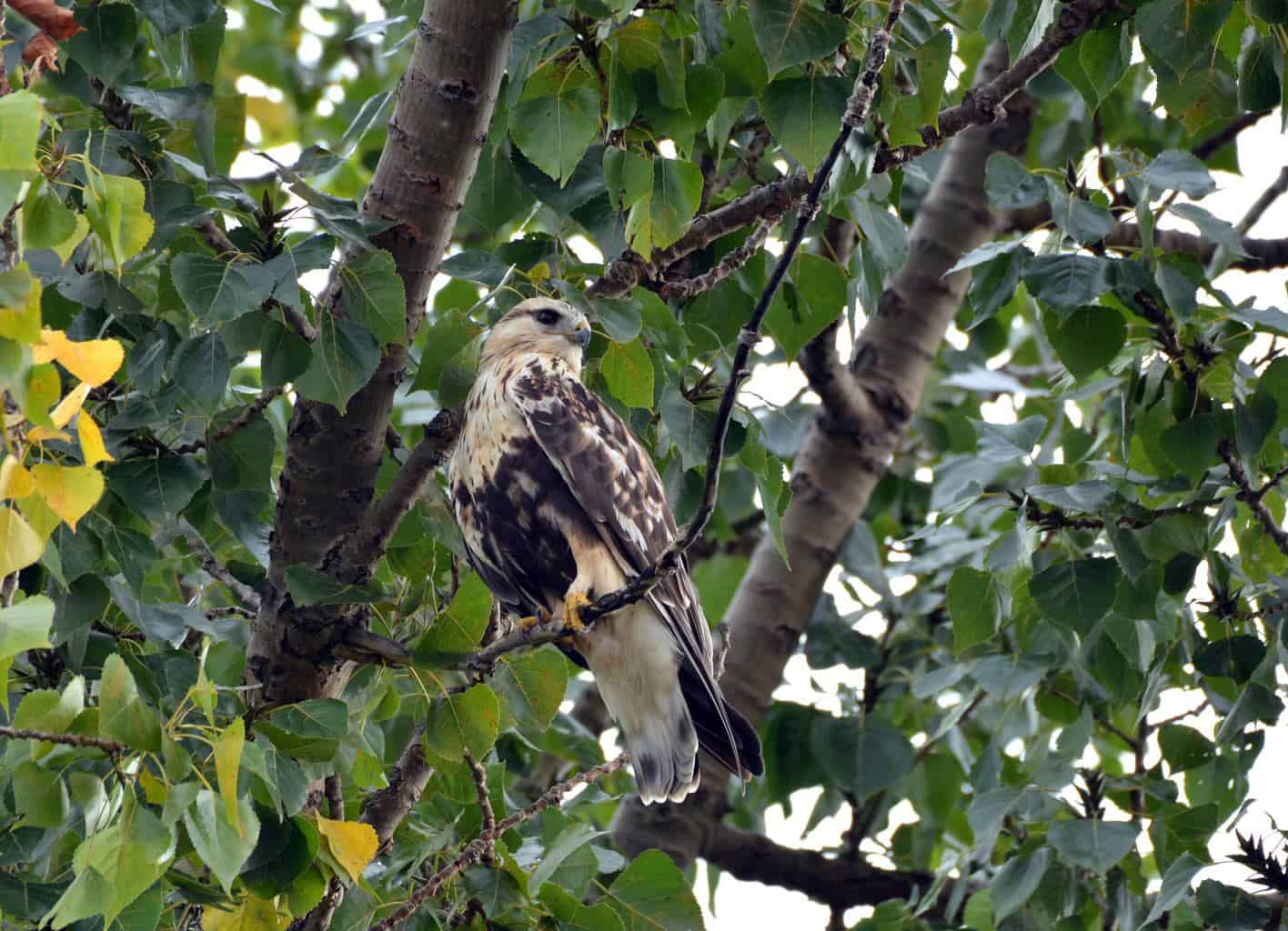
- Scientific Name: Buteo lagopus
- Length: 18.5-20.5 inches
- Weight: 25.2-49.4 ounces
- Wingspan: 52.0-54.3 inches
Our friend the rough-legged hawk can only be found in Texas during the winter months. When spring has sprung, the bird heads north to the arctic tundra to breed.
The hawk is named for the bird’s most defining characteristic: the feathers that grow down their legs to their feet. This is a feature that’s only shared with two other United States raptors, the ferruginous hawk and the golden eagle. Rough-legged hawks can also be characterized for their blotchy appearance and widely-spread wings when they’re soaring above or flying between utility poles, treetops, and fence posts.
Ferruginous Hawk

- Scientific Name: Buteo regalis
- Length: 22.1-27.2 inches
- Weight: 34.5-73.2 ounces
- Wingspan: 52.4-55.9 inches
The ferruginous hawk is the largest hawk species in both Texas and the United States as a whole, and the bird is characterized by its huge body along with rusty shoulders and legs. They also have legs full of shaggy feathers, just like the rough-legged species above.
You’ll find this big bird flying over prairies, open spaces, and grasslands as they look for something to eat. Their diet is pretty varied, including everything from grasshoppers to small mammals.
Northern Harrier

- Scientific Name: Circus hudsonius
- Length: 18.1-19.7 inches
- Weight: 10.6-26.5 ounces
- Wingspan: 40.2-46.5 inches
The northern harrier is quite a special bird, as it’s the only harrier species indigenous to the region and found in North America. It’s genetically classified as a hawk, but it has looks and behaviors of its own that make it stand out from other types of hawks.
These birds also share traits with owls, including flat faces, sharply hooked bills, and relying on their hearing to catch prey as they hunt in open fields, marshes, and riversides.
Northern harriers are stealthy, intelligent hunters, too. Once they’ve caught their prey, which is usually small mammals and birds, they often drown them to guarantee the victim can’t fight back or getaway.
Crane Hawk

- Scientific Name: Geranospiza caerulescens
- Length: 20 inches
- Weight: 7.9-12.6 ounces (males), 9.6-15.2 ounces (females)
- Wingspan: 40 inches
Another rarely sighted bird in Texas is the crane hawk. Multiple bird watchers have claimed to find the bird in national parks, however, only a single sighting has ever been documented in the state. So, you’d have to be extremely lucky to come across one!
It has bright red legs with a full coat of gray feathers on its body, except on the tail where it has a thick white band of feathers.
Harris’s Hawk

- Scientific Name: Parabuteo unicinctus
- Length: 18.1-23.2 inches
- Weight: 18.2-31.0 ounces
- Wingspan: 40.5-46.9 inches
Harris’s hawk is regularly found in the southern region of North America, from San Antonio to areas even further south. The more you travel in that direction, the more common it is for you to see these hawks.
Their bodies are covered in dark gray to black feathers, making it pretty easy to spot the bird with binoculars, and while their tail feathers are dark brown, their rumps are white.
They usually hunt in open spaces, so they perch on heavily wooded areas and large dense trees. Their diet is pretty varied, and they’ll eat anything from small mammals to large lizards and insects.
Roadside Hawk

- Scientific Name: Rupornis magnirostris
- Length: 13-16 inches
- Weight: 24 ounces
- Wingspan: 27-31 inches
The roadside hawk is both marvelous-looking and quite small. Their chest and wing feathers are various shades of brown, heads are gray, and beaks are black-tipped.
Finding this bird in Texas is pretty hard to do; only 15 people have ever reported seeing it. If you hope to be number 16, you’ll need to be near a forest edge in the southern part of Texas and close to the Rio Grande River. If you hear rumors of these birds flitting about near you, there’s no need to rush; they tend to stay in the same spot for a couple of days unless they’re disturbed.
White-Tailed Hawk
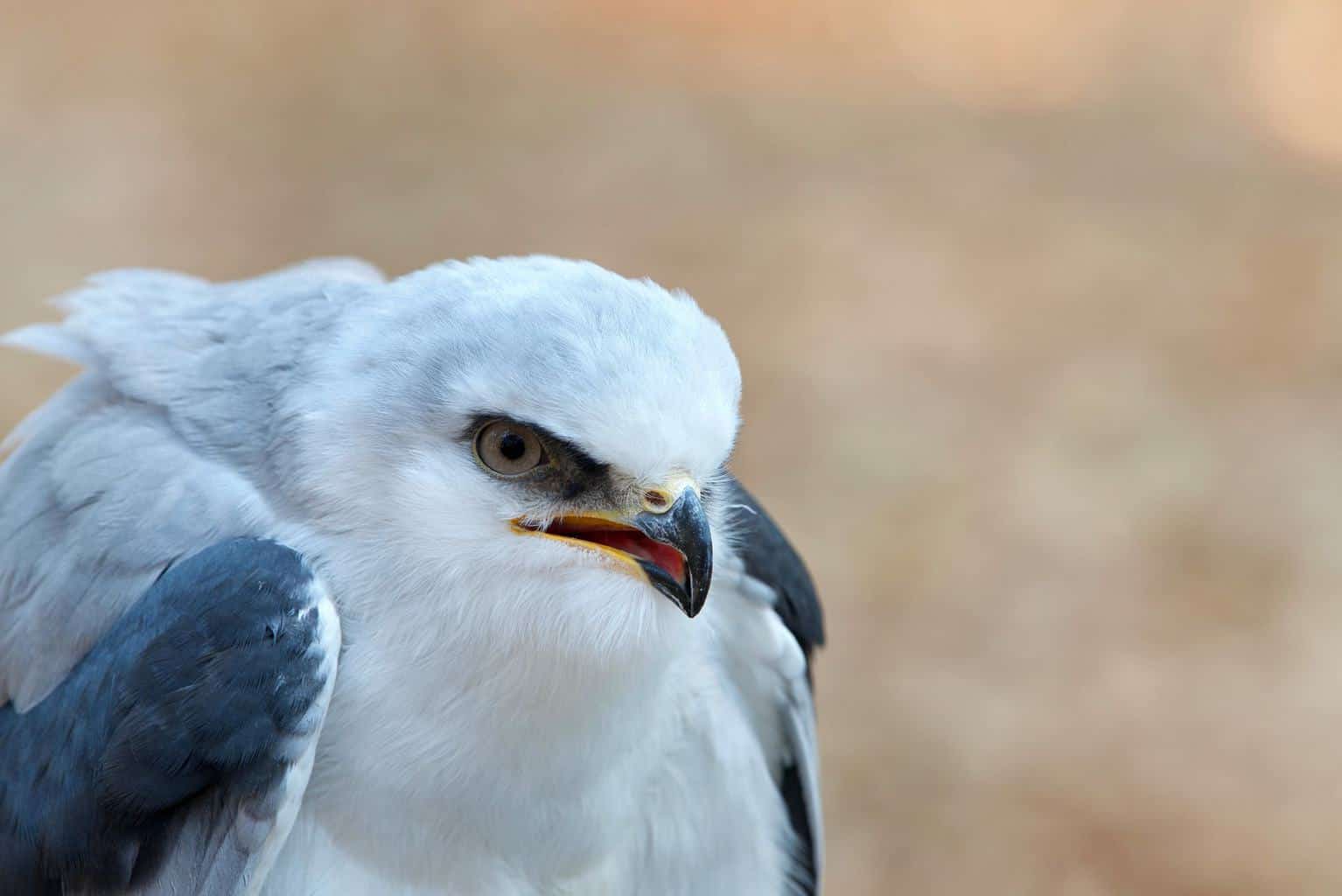
- Scientific Name: Geranoaetus albicaudatus
- Length: 20-22 inches
- Weight: 30.4 ounces
- Wingspan: 47-49 inches
You’ll find the white-tailed hawk in a variety of parks and nature reserves across Texas, especially across the coastal line. They’re one of the few hawks you can easily see from a distance without binoculars, as they have a unique bright tail with a single thick band that is usually dark black and shifted towards the tips of the tail.
When it’s time for dinner, almost everything is on the menu: rats, mice, pocket gophers, frogs — these hawks eat it all.
Gray Hawk

- Scientific Name: Buteo plagiatus
- Length: 18-24 inches
- Weight: 13.8-16.6 ounces
- Wingspan: 35 inches
Much like the roadside hawk species, gray hawks are also only found near the south and across the border with Mexico, especially the western half of Texas. You can usually find these birds perched in the branches of high trees, carefully watching everything going on below. If you don’t see it, you’ll likely hear it, as its loud whistles are hard to miss.
Despite their name, they’re usually characterized by having a subtle reddish-brown mottling on the wings. Their backs, however, are a pale shade of gray, and their under-tail coverts are marked by white feathers.
Short-Tailed Hawk

- Scientific Name: Buteo brachyurus
- Length: 15-17 inches
- Weight: 0.86-1.1 pounds
- Wingspan: 35 inches
The short-tailed hawk is relatively rare in Texas. It’s common in South America, but it occasionally makes its way north to the Lone Star State. Only about 75 individuals have reported seeing this bird in the state, but don’t let that discourage you in your birdwatching endeavors. Just look for a hawk with a clean, white breast and mostly white and black-tipped wings, and you just might discover it’s a member of this species.
These hunters rarely sit perched on a branch waiting for their prey; they prefer to take action instead. These birds often hover in the air until they spot their next victim. Then, at the perfect moment, they take a steep dive and snatch up a small bird to eat. The short-tailed hawk may also settle for a snake, lizard, or tree frog from time to time.
Zone-Tailed Hawk
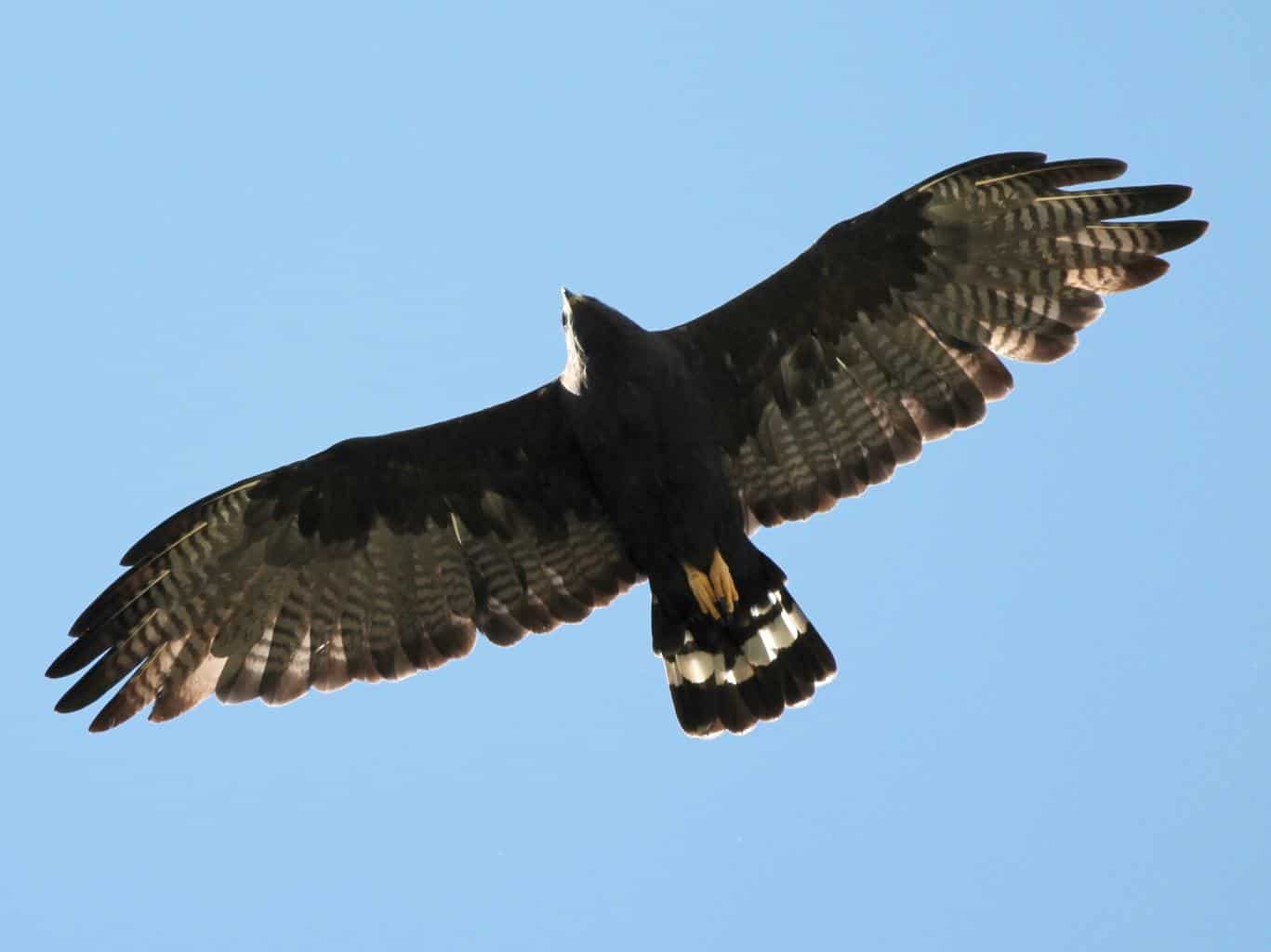
- Scientific Name: Buteo albonatus
- Length: 17.7-22.1 inches
- Weight: 1.2-2.1 pounds
- Wingspan: 47 inches
Yet another rare Texas bird is the zone-tailed hawk. This species is occasional, meaning you won’t regularly find it in the state, but thanks to its ability to adapt to environmental changes, it just might show up. If you’re lucky, you’ll stumble across one of them in the state’s western range.
This bird is pretty easy to spot, with a characteristic all-black body that’s unlike many other species found in the area. The black and white striped underwings mimic the two-toned turkey vulture, and their black tails have white bands. Be careful not to confuse the two similar-looking birds, though; while the turkey vulture is generally harmless, the zone-tailed bird just might get defensive if you get too close.
Common Black Hawk

- Scientific Name: Buteogallus anthracinus
- Length: 21 inches
- Weight: 1.8 pounds
- Wingspan: 50 inches
The common black hawk has the word common in its name, the reality is quite the opposite…if you’re in Texas, at least. You might find them in the western part of the state, but only in the summertime and if you’ve got a bit of luck on your side, as this hawk is a rare sight in Texas because they live near the desert. They’re mostly seen near the Davis Mountains in Big Bend National Park.
This medium-sized raptor is mostly black or dark gray, and its short black tail has a single white stripe and a matching tip. They’re diurnal birds who mostly fly in pairs looking for small vertebrates to eat.
Great Black Hawk
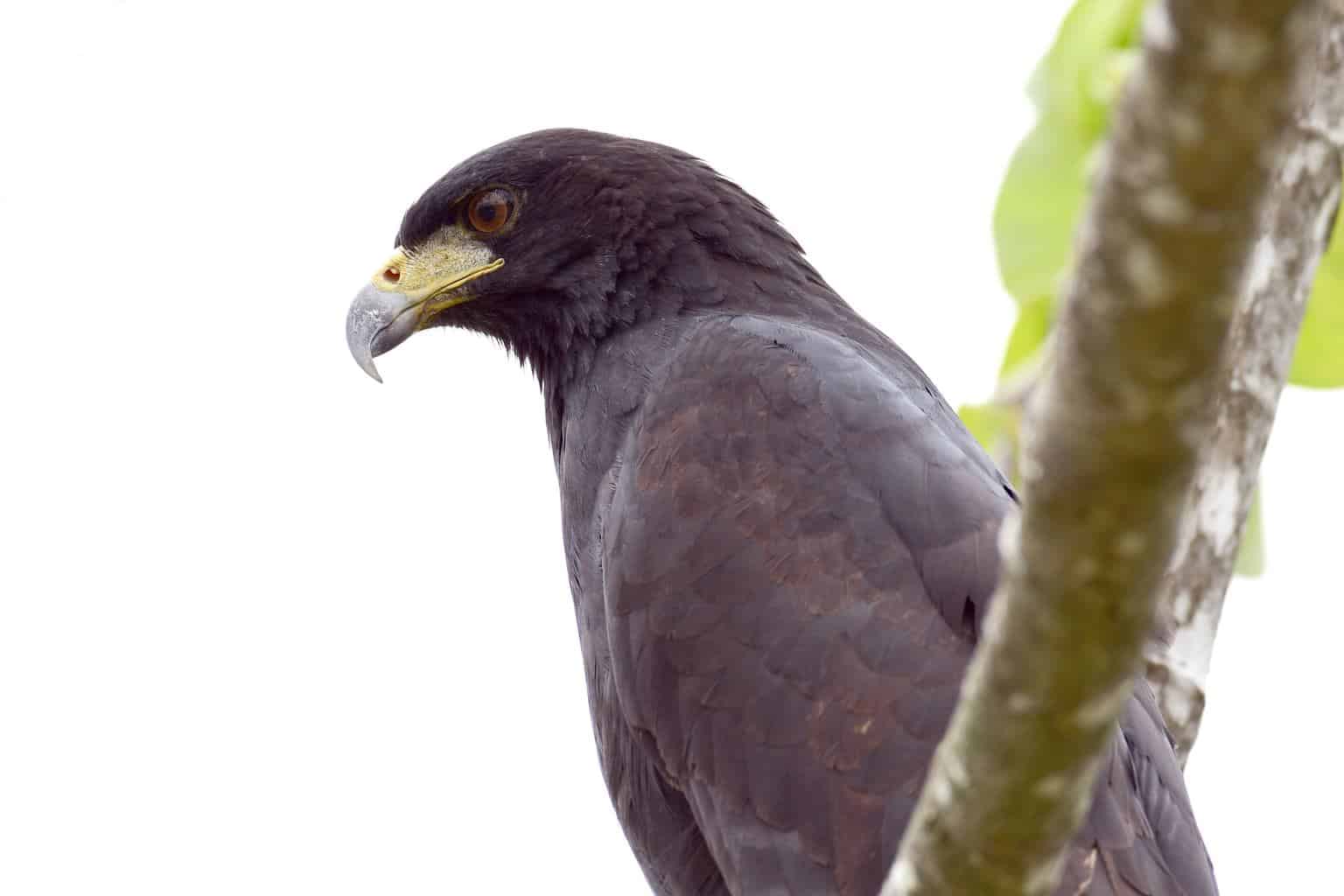
- Scientific Name: Buteogallus urubitinga
- Length: 22-25 inches
- Weight: 1.8 pounds
- Wingspan: 45-53 inches
Until very recently, the great black hawk wasn’t a species of hawks that you would find in Texas. However, since late 2018, the hawk is reportedly seen in multiple documented sightings.
As the name suggests, the great black hawk looks quite similar to the common one but slightly larger, with a large body and a yellowish beak with a black tip.
Wrap Up
And that concludes our list of hawk species in Texas! As you can see, the Lone Star State is one of the best spots for birdwatchers — especially those who love hawks, since it has such a wide variety of species compared to other states.
Interested in more than just birds of prey? Texas is home to an array of woodpeckers, too; check them out here!

